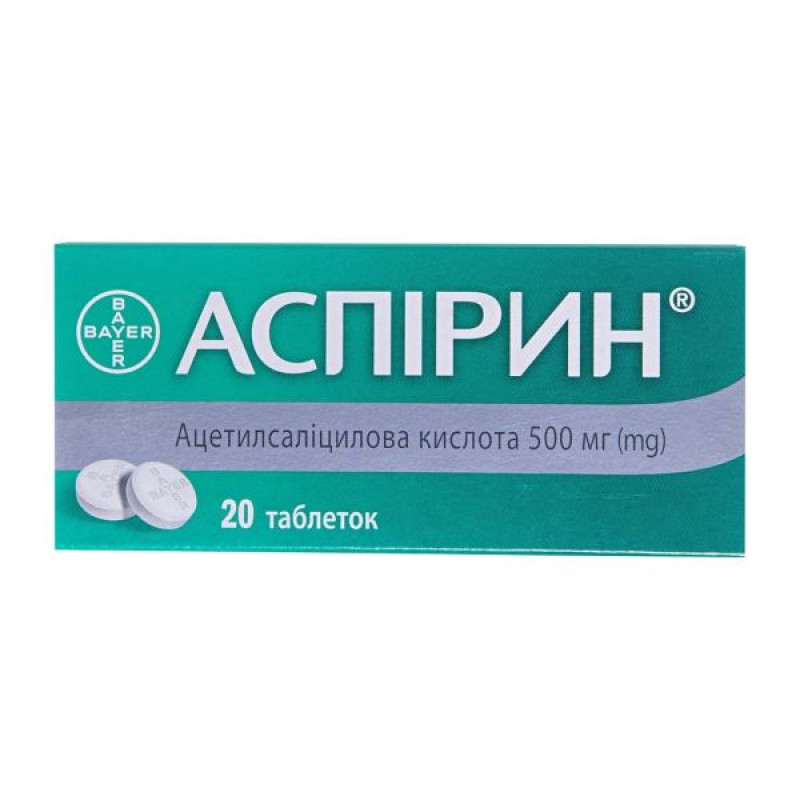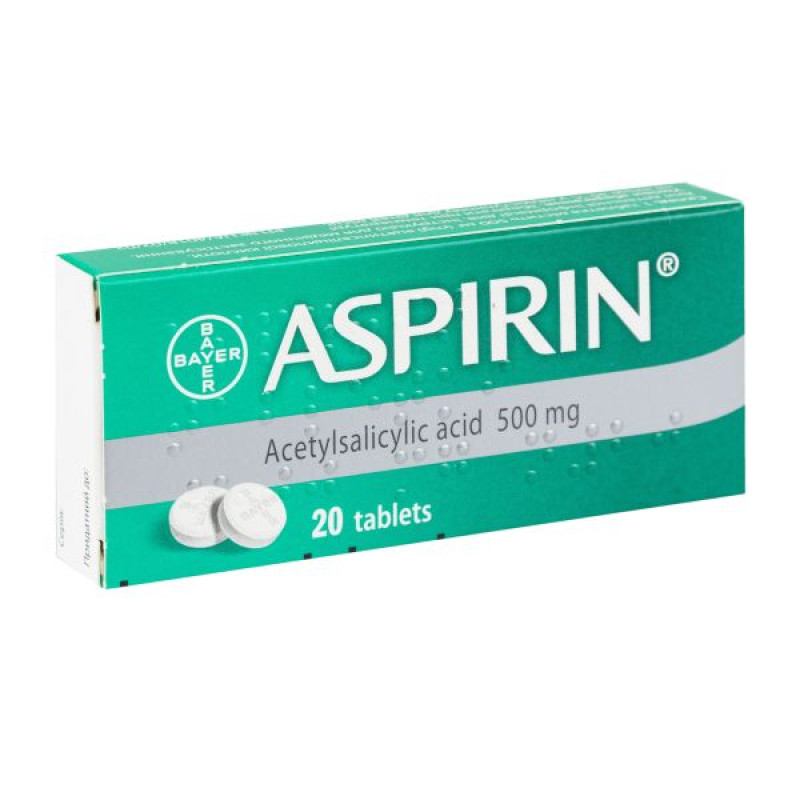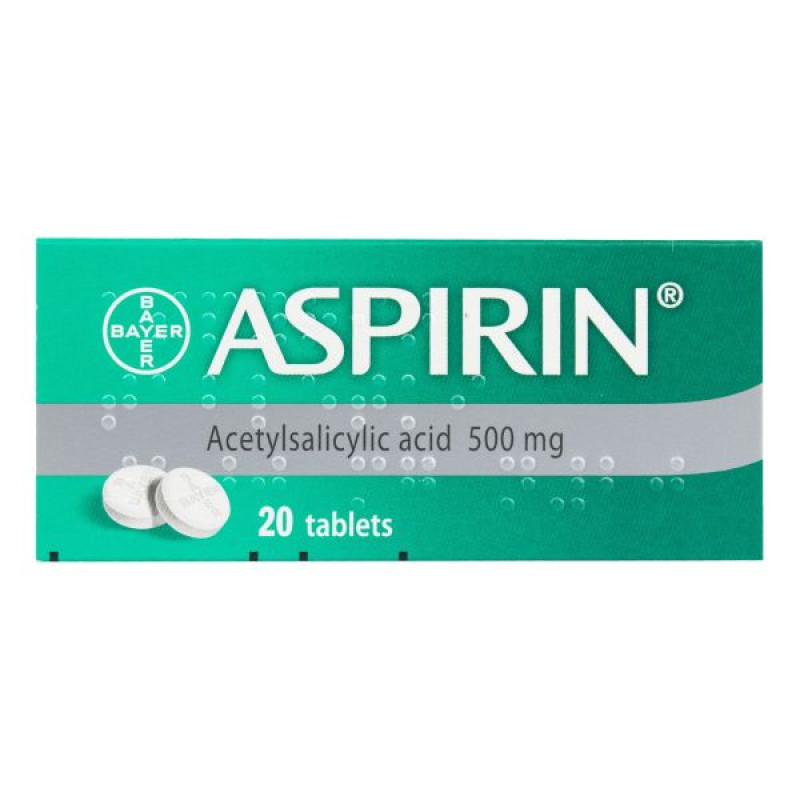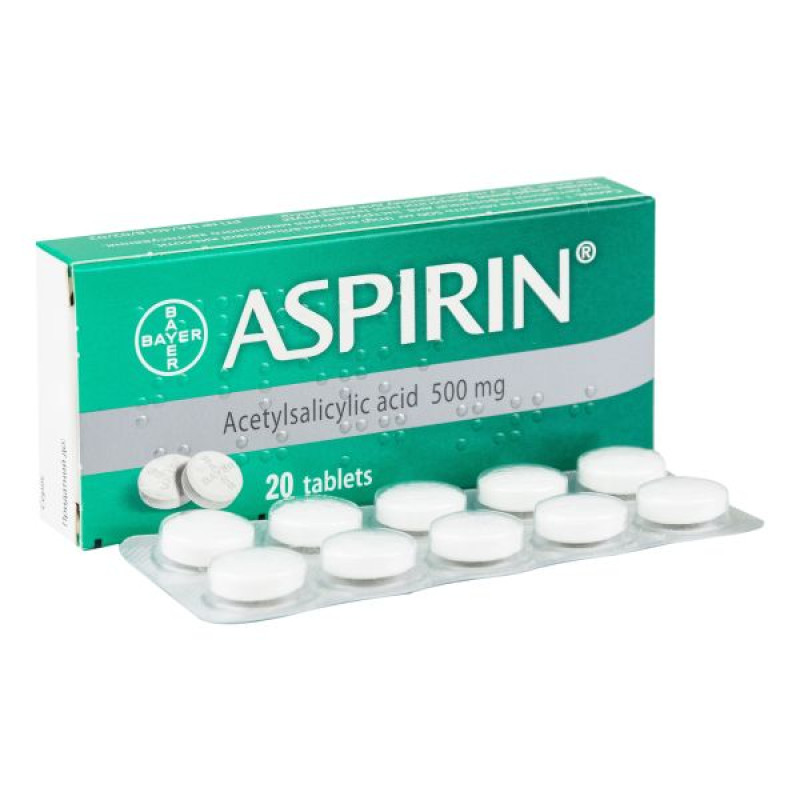Aspirin tablets 500 mg No. 20

Instructions Aspirin tablets 500 mg No. 20
Composition
active ingredient: acetylsalicylic acid;
1 tablet contains 500 mg of acetylsalicylic acid;
excipients: powdered cellulose, corn starch.
Dosage form
Pills.
Main physicochemical properties: white, round tablets with engraving in the form of a “Bayer cross” on one side of the tablet and the inscription “ASPIRIN 0.5” on the other.
Pharmacotherapeutic group
Nervous system. Analgesics. Other analgesics and antipyretics. Salicylic acid and derivatives. Acetylsalicylic acid.
ATX code N02B A01.
Pharmacological properties
Pharmacodynamics
Acetylsalicylic acid belongs to the group of nonsteroidal anti-inflammatory drugs (NSAIDs) and has analgesic, antipyretic and anti-inflammatory properties. Its mechanism of action is the irreversible inactivation of cyclooxygenase enzymes, which play an important role in the synthesis of prostaglandins.
Orally, in doses of 0.3 g to 1 g, acetylsalicylic acid is used to relieve pain and conditions accompanied by fever, such as colds, to reduce fever and relieve pain in joints and muscles.
Acetylsalicylic acid inhibits platelet aggregation by blocking the synthesis of thromboxane A2.
Pharmacokinetics
After oral administration, acetylsalicylic acid is rapidly and completely absorbed from the gastrointestinal tract. During and after absorption, it is converted into the main active metabolite - salicylic acid. The maximum concentration of acetylsalicylic acid in the blood plasma is reached after 10-20 minutes, salicylates - after 20-120 minutes.
Acetylsalicylic and salicylic acids are completely bound to blood plasma proteins and are rapidly distributed in the body.
Salicylic acid crosses the placenta and is excreted in breast milk.
Salicylic acid is metabolized in the liver. The metabolites of salicylic acid are salicylicuric acid, salicylphenol glucuronide, salicylacyl glucuronide, gentisic acid, and gentisinuric acid.
The elimination kinetics of salicylic acid are dose-dependent, as metabolism is limited by the activity of hepatic enzymes. The half-life is dose-dependent and increases from 2-3 hours at low doses to 15 hours at high doses. Salicylic acid and its metabolites are excreted from the body mainly by the kidneys.
Indication
treatment of mild to moderately severe, acute pain syndrome (headache, toothache, joint and ligament pain, back pain); symptomatic treatment of fever and/or pain syndrome in colds.
Contraindication
hypersensitivity to acetylsalicylic acid, other salicylates or to any component of the drug; bronchial asthma caused by the use of salicylates or other NSAIDs. in history; acute gastrointestinal ulcers; hemorrhagic diathesis; severe renal failure; severe hepatic failure; severe heart failure;
combination with methotrexate at a dosage of 15 mg/week or more (see section “Interaction with other medicinal products and other types of interactions”);
Third trimester of pregnancy.
Incompatibility.
The use of methotrexate in doses of 15 mg/week or more increases the hematological toxicity of methotrexate (reduction in renal clearance of methotrexate by anti-inflammatory agents and displacement of methotrexate from plasma protein binding by salicylates).
Interaction with other medicinal products and other types of interactions
Contraindicated combinations.
The use of acetylsalicylic acid with methotrexate at doses of 15 mg/week or more increases the hematological toxicity of methotrexate (reduction in renal clearance of methotrexate by anti-inflammatory agents and displacement of methotrexate from plasma protein binding by salicylates).
Combinations that should be used with caution.
When using acetylsalicylic acid with methotrexate in doses less than 15 mg/week, the hematological toxicity of methotrexate increases (reduction in renal clearance of methotrexate by anti-inflammatory agents and displacement of methotrexate from plasma protein binding by salicylates).
Concomitant use of ibuprofen prevents irreversible platelet inhibition by acetylsalicylic acid. Treatment of patients at risk of cardiovascular disease with ibuprofen may limit the cardioprotective effect of acetylsalicylic acid.
The simultaneous use of high doses of salicylates with NSAIDs (due to a mutually reinforcing effect) increases the risk of ulcers and gastrointestinal bleeding.
The risk of bleeding increases with the simultaneous use of Aspirin and anticoagulants, thrombolytics and platelet aggregation inhibitors (e.g. ticlopidine, clopidogrel). Therefore, patients requiring thrombolytic therapy should be monitored for symptoms of external or internal bleeding.
When used simultaneously with digoxin, the concentration of the latter in blood plasma increases due to reduced renal excretion.
With the simultaneous use of high doses of acetylsalicylic acid and oral antidiabetic drugs from the group of sulfonylurea derivatives or insulin, the hypoglycemic effect of the latter is enhanced due to the hypoglycemic effect of acetylsalicylic acid and the displacement of sulfonylurea bound to blood plasma proteins.
Diuretics in combination with high doses of acetylsalicylic acid reduce glomerular filtration by reducing prostaglandin synthesis in the kidneys.
Systemic glucocorticosteroids (except hydrocortisone, which is used for replacement therapy in Addison's disease). When using acetylsalicylic acid simultaneously with corticosteroids, the level of salicylates in the blood decreases and the risk of overdose increases after the end of treatment, as well as the risk of gastrointestinal bleeding increases.
ACE inhibitors in combination with high doses of acetylsalicylic acid cause a decrease in glomerular filtration due to inhibition of vasodilator prostaglandins and a decrease in the hypotensive effect.
Selective serotonin reuptake inhibitors: Increased risk of upper gastrointestinal bleeding due to possible synergistic effect.
When used simultaneously with valproic acid, acetylsalicylic acid displaces it from its association with blood plasma proteins, increasing the toxicity of the latter.
Ethyl alcohol contributes to damage to the mucous membrane of the gastrointestinal tract and prolongs bleeding time due to the synergism of acetylsalicylic acid and alcohol.
Application features
Aspirin is used with caution in:
hypersensitivity to analgesics, anti-inflammatory, antirheumatic drugs, as well as in the presence of allergies to other substances; history of gastrointestinal ulcers, including chronic or recurrent peptic ulcer disease or history of gastrointestinal bleeding; concomitant use of anticoagulants; impaired renal function or circulatory disorders (such as renal vascular disease, congestive heart failure, dehydration, major surgery, sepsis or significant blood loss), since acetylsalicylic acid may further increase the risk of kidney damage and cause acute renal failure; impaired liver function.
In patients with allergic complications, including bronchial asthma, allergic rhinitis, urticaria, skin itching, swelling of the mucous membrane and nasal polyps, as well as in combination with chronic respiratory tract infections and in patients with hypersensitivity to NSAIDs, bronchospasm, bronchial asthma attacks or other hypersensitivity reactions may develop during treatment with Aspirin®.
Due to its effect on platelet aggregation inhibition, which lasts up to several days after administration, acetylsalicylic acid may increase the tendency to bleed during and after surgery (including minor operations such as tooth extraction).
When using low doses of acetylsalicylic acid, uric acid excretion may be reduced. This may lead to a gout attack in patients with reduced uric acid excretion.
In patients with glucose-6-phosphate dehydrogenase deficiency, acetylsalicylic acid may cause hemolysis or hemolytic anemia. Factors that increase the risk of hemolysis are, for example, the use of high doses of the drug, fever or acute infections.
Prolonged use of analgesics can lead to headaches.
Frequent use of painkillers can cause temporary kidney damage with the risk of developing kidney failure (analgesic nephropathy). The risk is particularly high when several different analgesics are used simultaneously.
Ability to influence reaction speed when driving vehicles or other mechanisms
No effect on the ability to drive or use other mechanisms was noted.
Use during pregnancy or breastfeeding
Pregnancy.
Aspirin should only be used during pregnancy if other medications are not effective, and only after assessing the risk/benefit ratio.
Inhibition of prostaglandin synthesis may adversely affect pregnancy and/or embryonal/fetal development. Available epidemiological data indicate a risk of miscarriage and foetal malformations after the use of prostaglandin synthesis inhibitors in early pregnancy. The risk increases with increasing dose and duration of therapy.
The available epidemiological data on the occurrence of malformations are not consistent, but an increased risk of gastroschisis cannot be excluded with the use of acetylsalicylic acid.
Animal studies indicate reproductive toxicity.
During the third trimester of pregnancy, all prostaglandin synthesis inhibitors may affect the fetus in the following ways:
Cardiopulmonary toxicity (with premature closure of the ductus arteriosus and pulmonary hypertension); renal dysfunction with possible further development of renal failure with oligohydramnios.
Prostaglandin synthesis inhibitors can affect the woman and fetus at the end of pregnancy in the following ways:
Possible prolongation of bleeding time, antiplatelet effect that may occur even after very low doses, inhibition of uterine contractions, which may lead to delayed or prolonged labor.
Given this, acetylsalicylic acid is contraindicated during the third trimester of pregnancy.
Fertility
There is some evidence that drugs that inhibit prostaglandin synthesis may impair female reproductive function by affecting ovulation. This effect is reversible and disappears after discontinuation of treatment.
Breast-feeding.
Salicylates and their metabolites pass into breast milk in small amounts.
Since adverse reactions in infants whose mothers took acetylsalicylic acid for a short time were not observed, interruption of breastfeeding is usually not necessary. In the case of long-term use of acetylsalicylic acid in high doses, breastfeeding should be discontinued.
Method of administration and doses
Aspirin is taken orally after meals, with sufficient liquid (for example, a glass of water). Patients with impaired swallowing function can dissolve the tablets in a spoonful of water.
Aspirin should not be used for longer than 4 days without consulting a doctor.
Adults and children aged 15 and over.
1–2 tablets as a single dose. Repeated administration is possible after 4–8 hours. The maximum daily dose should not exceed 3 g (6 tablets).
Warning.
For patients with concomitant liver or kidney dysfunction, the dose of the drug should be reduced or the interval between applications should be increased. This drug should not be used on an empty stomach.
Children
The drug is used in children over 15 years of age.
Do not use acetylsalicylic acid-containing drugs in children with acute respiratory viral infections (ARI), with or without fever, without consulting a doctor. With some viral diseases, especially influenza A, influenza B and chickenpox, there is a risk of developing Reye's syndrome, which is a very rare but life-threatening disease that requires immediate medical attention. The risk may be increased if acetylsalicylic acid is used as a concomitant drug, but a causal relationship in this case has not been proven. If these conditions are accompanied by prolonged vomiting, this may be a sign of Reye's syndrome.
Overdose
Salicylate toxicity (administration of more than 100 mg/kg/day for more than 2 days may cause toxicity) is possible due to chronic intoxication resulting from prolonged therapy, as well as acute intoxication (overdose), which is potentially life-threatening and may be caused, for example, by accidental use by children or overdose.
Chronic salicylate intoxication can be insidious because its signs are nonspecific. Moderate chronic salicylate intoxication, or salicylism, usually occurs only after repeated use of large doses.
Symptoms: Dizziness, tinnitus, deafness, sweating, nausea and vomiting, headache, confusion. These symptoms can be controlled by reducing the dose. Tinnitus is possible at plasma salicylate concentrations above 150–300 μg/ml. More serious adverse reactions are observed at plasma salicylate concentrations above 300 μg/ml.
Acute intoxication is evidenced by a pronounced change in acid-base balance, which depends on the age of the patient and the severity of intoxication. In children, the most characteristic manifestation is metabolic acidosis. The severity of the condition cannot be assessed solely on the basis of the concentration of salicylates in the blood plasma. The absorption of acetylsalicylic acid may be slowed down due to delayed gastric release, the formation of concrements in the stomach or when the drug is taken in the form of enteric-coated tablets.
Due to the complex pathophysiological effects, signs and symptoms of salicylate poisoning may include:
Mild to moderate intoxication – tachypnea, hyperpnea, respiratory alkalosis, sweating, nausea, and vomiting.
Changes in laboratory and other parameters: alkalemia, alkaluria, acidemia, aciduria, changes in blood pressure, changes in ECG, hypokalemia, hypernatremia, hyponatremia, changes in renal function, hyperglycemia, hypoglycemia (especially in children). Increased level of ketone bodies, hypoprothrombinemia.
Treatment.
If salicylate poisoning is suspected, immediate hospitalization in a specialized department is necessary. Treatment of intoxication caused by an overdose of acetylsalicylic acid is determined by the severity, clinical symptoms and is provided by standard methods used in poisoning (gastric lavage, use of activated charcoal, forced diuresis, symptomatic treatment, replenishment of fluid losses). All measures taken should be aimed at accelerating the removal of the drug and restoring the electrolyte and acid-base state. Depending on the state of acid-base balance and electrolyte balance, infusion of electrolyte solutions is performed. Alkaline diuresis is performed to achieve a urine pH of 7.5–8; forced alkaline diuresis is performed when the concentration of salicylates in plasma is > 500 mg/l (3.6 mmol/l) in adults or > 300 mg/l (2.2 mmol/l) in children. In case of severe intoxication, hemodialysis is indicated.
Adverse reactions
The list of adverse reactions given below includes all known adverse reactions that have developed in connection with the therapeutic use of acetylsalicylic acid, including those observed in patients with rheumatism who have been treated in high doses for a long time. The data on the frequency of use, with the exception of isolated cases, refer to the short-term use of daily doses of a maximum of 3 g of acetylsalicylic acid.
The following classification was used to determine the frequency of adverse reactions.
Very common: ≥ 1/10; Common: ≥ 1/100 to < 1/10; Uncommon: ≥ 1/1,000 to < 1/100; Rare: ≥ 1/10,000 to < 1/1,000; Very rare: < 1/10,000. Frequency not known: frequency cannot be estimated from the available data.
Gastrointestinal disorders: Common: dyspepsia, including epigastric and abdominal pain, heartburn, nausea, vomiting; rare: gastrointestinal inflammation, erosive-ulcerative lesions of the gastrointestinal tract, which in isolated cases can cause gastrointestinal bleeding and perforation with corresponding laboratory and clinical manifestations; frequency unknown: diaphragmatic bowel disease (especially with long-term treatment); very rare: transient hepatic failure with increased levels of hepatic transaminases.
Blood and lymphatic system disorders: Due to its antiplatelet effect on platelets, acetylsalicylic acid may increase the risk of bleeding. Bleeding such as perioperative bleeding, hematomas, urogenital bleeding, epistaxis, gingival bleeding have been reported rarely; serious bleeding such as gastrointestinal bleeding and cerebral hemorrhage (especially in patients with uncontrolled hypertension and/or concomitant use of antihemostatic agents), which in isolated cases may be life-threatening, has been reported rarely or very rarely. Bleeding tendency may occur within 4-8 days after the use of acetylsalicylic acid.
Very rarely, bleeding can lead to acute and chronic posthemorrhagic anemia/iron deficiency anemia (due to so-called occult microbleeding) with corresponding laboratory manifestations and clinical symptoms such as asthenia, pallor of the skin, hypoperfusion.
Hemolysis and the development of hemolytic anemia have been reported in patients with severe glucose-6-phosphate dehydrogenase deficiency.
On the part of the immune system. Rarely: in patients with individual hypersensitivity to salicylates, allergic reactions may develop, including symptoms such as rhinitis, shortness of breath, nasal congestion, and decreased blood pressure. Severe hypersensitivity reactions, including anaphylactic shock, angioedema, and noncardiogenic pulmonary edema, have been observed rarely. In patients with bronchial asthma, an increased frequency of bronchospasm, allergic reactions of mild to moderate severity, potentially affecting the skin, respiratory system, gastrointestinal tract, and cardiovascular system, may occur.
Skin and subcutaneous tissue disorders: Uncommon: hypersensitivity reactions, including skin reactions (e.g. rash, urticaria, pruritus, eczema). Rare: severe hypersensitivity reactions, e.g. erythema multiforme.
Nervous system: Headache, dizziness, hearing impairment, ringing in the ears and confusion may be signs of overdose.
Urinary system: Renal dysfunction and acute renal failure have been reported.
Expiration date
5 years.
Do not use after the expiry date stated on the packaging.
Storage conditions
Store at a temperature not exceeding 30 °C out of the reach of children.
Packaging
10 tablets in a blister, 2 blisters in a cardboard box.
Vacation category
Without a prescription.
Producer
Location of the manufacturer and its business address
Ortsteil Gräppin, Seilgaster Schloss 1, 06803 Bitterfeld-Wolfen, Germany.
There are no reviews for this product.
There are no reviews for this product, be the first to leave your review.
No questions about this product, be the first and ask your question.







